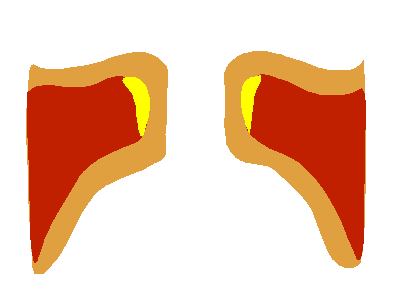This site is under construction! Stuff be missing, beware! :3 Contribute!
If you have issues, additions, corrections or concerns, open an issue or contact a maintainer.
The wiki needs an overhaul and so any information, corrections, etc are greatly appreciated.Table of contents
Vocal Mechanisms
A vocal mechanism or register is a distinct configuration of vocal fold interaction. Which, is a complicated way of saying…
- vocal mechanisms are distinct, they don’t overlap
- they describe how the vocal folds vibrate
- phonation is always within one of these mechanisms
- you can pass between mechanisms without a break with training

M0
fry
strohbass
pulse
M0 or vocal fry is at the bottom of your vocal range. Try going to your lowest note, then relax a little and go lower. The rough sound similar to an idling motorcycle engine is from M0. This is when the folds are slack and the whole fold vibrates.
- slack folds
- whole fold vibrates
- below your lowest M1 note
M1
normal speech
modal
chest voice
M1 is your normal speaking register.
- where most people speak the majority of the time
- most of the vocal folds vibrates

M2
falsetto
mix
head voice
M2 is a usually hollow, very high pitch register.
- sometimes has a gap between folds / lack of closure
- very high pitch
- the TA muscles deactivate somewhat
- mostly just mucosa of the folds vibrates

M3
whistle
flageolet
flute register
There are different theories and types of M3, but the main one is with mostly complete closure and a lot of tension, such that only a part of the folds vibrates.
- mostly only a small part of the folds vibrates and only the mucosa
- usually starts at 1000hz and can go as high as 5000hz or more.
This type of M3 is called stop closure whistle by Antonio Di Corcia and Franco Fussi’s paper↗ which puts forward the following findings:
FLW - Female Laryngeal Whistle
- “very thin, stiff and tightly stretched vocal folds”
- “Often, no contact between the folds during phonation was noted”
SCW – Stop Closure Whistle
- “the whistle sound depends on a tiny orifice at the anterior third of the folds”
- caused by high adduction
- “HSDI observation showed a total absence of vibration (normal periodic vibration) in any components of the vibrating system caused by the stop_closure phenomenon”
IW - Ingressive Whistle
- “high activity of the adductor muscles”
- “absence of vibrating parts during ingressive phonation”
Scream in M3
- “[…]very stretched, thin and stiff vocal folds and an high constriction of the false vocal folds”
- “[…]very further reduction of the mucosal wave vibration, very restricted to the edge of the fold”